“Perderò le classifiche di Google se sposto il mio blog?”. È la domanda numero uno che sentiamo ogni volta che chi siamo sta pensando di passare da Blogger a WordPress.
Lo capiamo, ma dopo aver aiutato innumerevoli blogger a compiere questa transizione, possiamo dirvi con sicurezza che è assolutamente possibile passare da Blogger a WordPress senza sacrificare il vostro posizionamento su Google.
Nel corso degli anni, abbiamo perfezionato il processo di migrazione per proteggere la vostra SEO mentre passate a una piattaforma di blog più potente. Attraverso prove ed errori, abbiamo scoperto esattamente cosa fare (e cosa evitare!) per proteggere il posto guadagnato con fatica nei risultati della ricerca di Google.
In questa guida vi illustreremo il nostro metodo collaudato per passare da Blogger a WordPress. Imparerete le stesse tecniche che abbiamo usato per aiutare innumerevoli blogger come voi a migliorare i loro siti senza sacrificare la loro visibilità nei motori di ricerca.
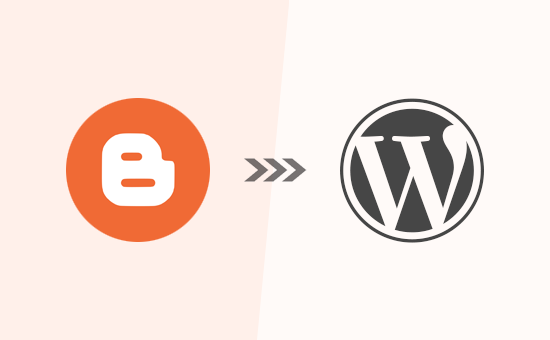
Perché passare da Blogger a WordPress?
Attualmente state usando Blogger, una popolare piattaforma di blog creata da Google che permette a chiunque di aprire un blog gratuito con il proprio account Google.
È un ottimo punto di partenza per molti, ma molti principianti si rendono subito conto che il loro blog gratuito su Blogger può sembrare un po’ limitato. Potreste ritrovarvi a desiderare di poter fare di più.
È qui che entra in gioco WordPress. A differenza di Blogger, WordPress.org vi dà il controllo completo del vostro sito web. Inoltre, vi permette di aggiungere le caratteristiche necessarie per far crescere il vostro blog e guadagnare online. E quando si tratta di farsi notare su Google, WordPress.org vi permette di effettuare tutte le modifiche SEO importanti per migliorare le vostre classifiche.
🌟 Volete maggiori informazioni? Abbiamo messo insieme un confronto dettagliato tra WordPress e Blogger, in modo che possiate vedere tutte le differenze.
Secondo le nostre statistiche di ricerca, WordPress è la piattaforma per siti web più diffusa al mondo e alimenta quasi il 43% di tutti i siti web.
Ciò significa che quando scegliete WordPress, vi unite a milioni di altri siti web di successo. Scegliete una piattaforma che gode della fiducia di moltissime persone e che è perfetta per mostrare i vostri contenuti.
Detto questo, esistono due tipi di software WordPress, per cui importa scegliere quello giusto.
Il primo è WordPress.com, che è un builder per siti web ospitati. Con WordPress.com, non è necessario trovare un piano di hosting e installare il software da soli. Potete invece scegliere un piano gratuito o acquistare uno dei piani a pagamento disponibili e Automattic ospiterà il vostro sito web per voi.
Poi c’è WordPress.org, noto anche come WordPress ospitato all’esterno. Consigliamo sempre di utilizzare WordPress.org perché, a differenza di WordPress.com, non è necessario pagare un piano costoso per poter installare i plugin (considerateli come degli add-on per il vostro nuovo sito web WordPress!).
Detto questo, vediamo come passare correttamente da Blogger a WordPress preservando le classifiche di ricerca su Google e il traffico del sito web.
Ecco tutti i passaggi che andremo a coprire per rendere il passaggio da Blogger a WordPress agevole e orientato alla SEO:
- Step 1. Sign up for WordPress Hosting
- Step 2. Export Your Blogger Blog
- Step 3. Import Blogger to WordPress
- Step 4. Setting Up Permalinks
- Step 5. Set Up Redirects From Blogger to WordPress
- Step 6. Moving Other Content From Blogger to WordPress
- Step 7. Things to Do After Migrating From Blogger to WordPress
- Video Tutorial
Pronti? Iniziamo.
Fase 1: Registrazione per l’hosting WordPress
Per iniziare a utilizzare WordPress, è necessario disporre di un nome di dominio e di un hosting web.
Per un rapido promemoria, il nome di dominio è l’indirizzo del vostro sito web che le persone digitano per raggiungere il vostro blog, mentre l’hosting web è il luogo in cui vengono memorizzati i file del vostro sito. Entrambi sono indispensabili per creare qualsiasi tipo di blog o sito web.
Detto questo, vi consigliamo di utilizzare Bluehost. Si tratta di una delle più grandi società di hosting al mondo e di un partner di hosting WordPress ufficialmente raccomandato.
Poiché WPBeginner è il più grande sito di risorse per WordPress, ha accettato di offrire ai nostri lettori un dominio gratuito e uno sconto del 60% sull’host. In pratica, potete iniziare a lavorare per soli 1,99 dollari al mese.
Se preferite un’alternativa a Bluehost, vi consigliamo di utilizzare SiteGround o Hostinger, perché sono entrambe soluzioni eccellenti (in effetti, noi utilizziamo SiteGround per ospitare WPBeginner!).
Una volta sottoscritto il piano di hosting WordPress e impostato il dominio, si può procedere alla fase di installazione di WordPress.
Se vi iscrivete a Bluehost utilizzando il nostro link qui sopra, vi installerà automaticamente WordPress.
Se avete utilizzato un altro provider di hosting WordPress, allora dovete installare WordPress seguendo la nostra guida definitiva su come installare WordPress.
Dopo aver installato WordPress, è il momento di spostare i contenuti da Blogger a WordPress.
🧑💻 Vi abbiamo sentito forte e cancellato! Poiché molti di voi ce lo hanno chiesto, siamo entusiasti di annunciare che ora offriamo un servizio di migrazione da Blogger a WordPress completamente gratuito come parte della configurazione gratuita del nostro blog WordPress! Proprio così: uno dei membri del nostro team di esperti si occuperà di tutto per voi, gratuitamente. Potrete letteralmente passare da Blogger al potente mondo di WordPress senza alcun problema o rischio.
Il nostro servizio gratuito di migrazione da Blogger è perfetto per i blog più piccoli, con meno di 1000 pubblicazioni. Se avete un sito Blogger più grande, non preoccupatevi! Possiamo comunque aiutarvi con la migrazione, ma si tratta di un servizio a pagamento.
Passo 1: Esportare il blog di Blogger
La prima cosa da fare è esportare i contenuti del blog Blogger. Per farlo, visitate il sito web di Blogger e accedete al cruscotto del vostro account.
Successivamente, andare alla pagina delle impostazioni. Scorrere fino alla sezione “Gestione del blog” e fare clic sul pulsante “Backup dei contenuti”.
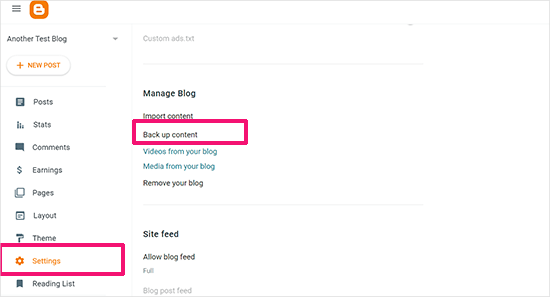
Verrà visualizzata una finestra a comparsa che mostra cosa è esattamente incluso nel backup di Blogger.
Per continuare è necessario fare clic sul pulsante “Download”.
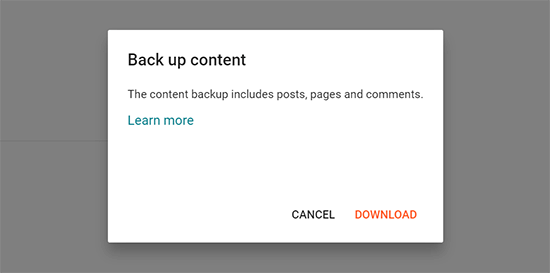
Il contenuto del vostro blog Blogger verrà scaricato sul vostro computer in un file XML.
Una volta completato il download, è il momento di importare i contenuti di Blogger nel sito WordPress.
Passo 2: Importare Blogger in WordPress
Per iniziare a importare il vostro sito Blogger in WordPress, accedete all’area di amministrazione di WordPress e visitate Strumenti ” Importazione.
Nella pagina di importazione, fare clic sul link “Installa ora” sotto Blogger.
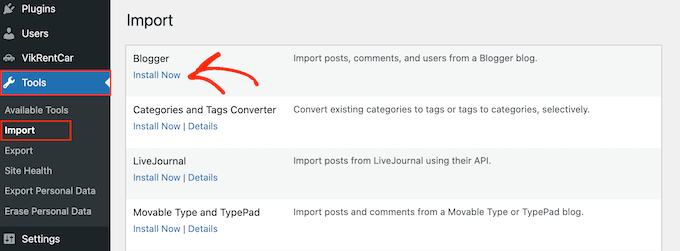
WordPress scaricherà e installerà il plugin Blogger Importer per voi.
Una volta terminata l’installazione, è necessario fare clic sul link “Run Importer” per continuare.
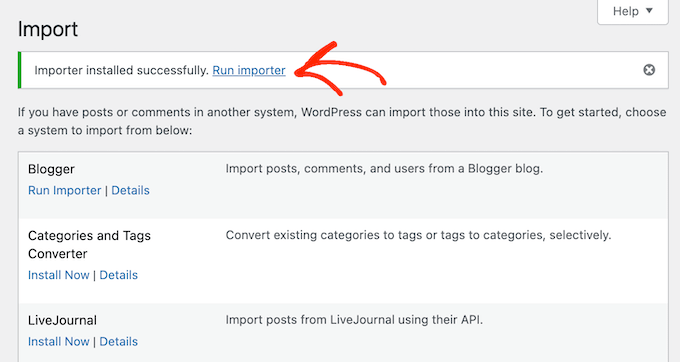
WordPress vi chiederà di caricare il file XML nella schermata Importa Blogger. Si tratta del file scaricato al punto 1.
È sufficiente fare clic sul pulsante “Scegli file” e caricare il file XML scaricato in precedenza.
Quindi, fare clic sul pulsante “Carica file e importa” per continuare.
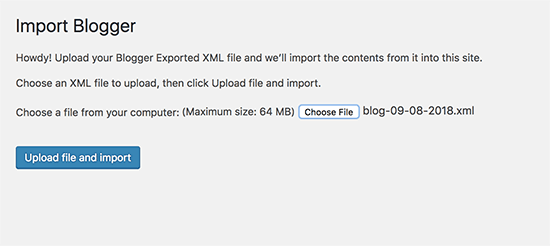
WordPress caricherà ora il file di importazione. Se il file di importazione è troppo grande, potrebbe essere visualizzato un messaggio di errore.
In questo caso, è necessario aumentare il limite massimo di caricamento dei file. Se il file è di piccole dimensioni, non si noterà alcun errore.
Successivamente, vi verrà chiesto di assegnare i post a un autore. Se avete più autori sul vostro blog Blogger, potete creare un nuovo account utente per ogni autore. Potete anche assegnare questi post ad autori esistenti sul vostro sito WordPress.
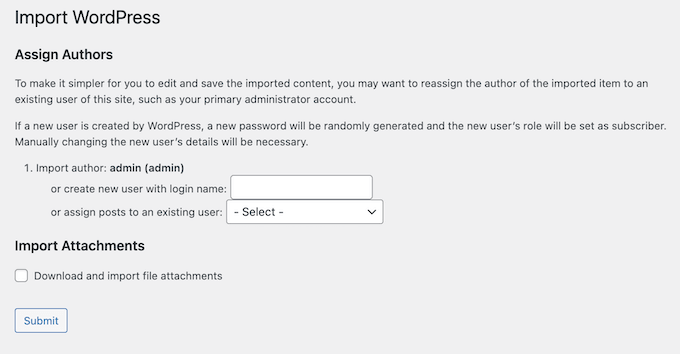
Dopo aver effettuato la selezione, fare clic sul pulsante “Invia” per continuare.
WordPress importerà tutti i contenuti dal file di esportazione di Blogger al vostro sito WordPress. È possibile visualizzare il contenuto visitando la pagina Post ” Tutti i post.
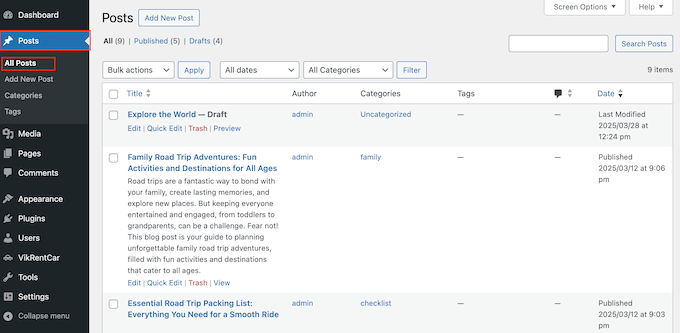
Passo 3: Impostazione dei permalink
Permalinks è il termine usato per la struttura degli URL delle singole pagine. WordPress è dotato di una funzione che consente di impostare una struttura URL SEO-friendly.
Poiché state importando contenuti da Blogger, è necessario che la struttura degli URL sia il più possibile simile a quella del vecchio sito di Blogger.
Per impostare i permalink, è necessario andare su Impostazioni ” Permalink nella dashboard di WordPress e scegliere l’opzione “Struttura personalizzata”.
Successivamente, è necessario aggiungere il seguente testo nella casella accanto al campo della struttura personalizzata:
1 | /%year%/%monthnum%/%postname%.html |
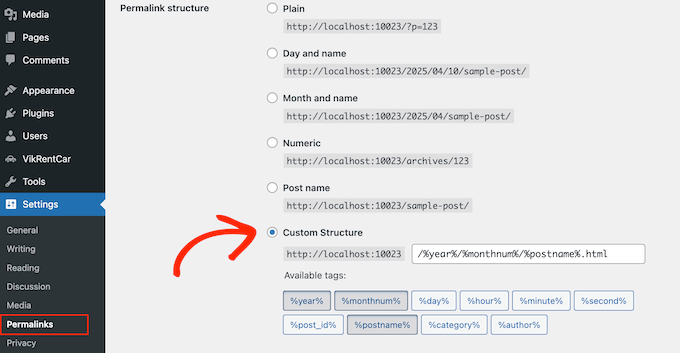
Questa struttura di permalink rende gli URL dei post del blog simili a quelli del vecchio blog di Blogger.
Tuttavia, a volte l’URL del post del blog, noto anche come slug in WordPress, non corrisponde agli slug utilizzati da Blogger.
Per risolvere questo problema, è necessario creare ed eseguire un piccolo frammento di codice.
Si consiglia di aggiungere questo codice PHP utilizzando il plugin WPCode. È il modo più sicuro per aggiungere codice personalizzato al vostro sito WordPress. Per maggiori dettagli, consultate la nostra guida su come copiare e incollare snippet di codice in WordPress.
1 2 3 4 5 6 7 8 9 10 11 12 13 14 | add_action( 'init', 'wpb_update_slug' );function wpb_update_slug() {global $wpdb;$result = $wpdb->get_results("SELECT post_id, meta_value FROM $wpdb->postmeta WHERE meta_key = 'blogger_permalink' ");$wpdb->print_error();foreach ($result as $row){$slug = explode("/",$row->meta_value);$slug = explode(".",$slug[3]);$wpdb->query("UPDATE $wpdb->posts SET post_name ='$slug[0]' WHERE ID = '$row->post_id' ");}echo "DONE";} |
Dopo aver salvato il codice, è sufficiente visitare una pagina qualsiasi del vostro sito WordPress per triggerare lo script. Dopo l’esecuzione dello script, non dimenticate di disabilitarlo o eliminarlo dalla libreria WPCode, perché deve essere eseguito solo una volta.
Passo 4: Impostare i reindirizzamenti da Blogger a WordPress
Il passo più importante nel trasferimento di un sito web è quello di impostare una corretta reindirizzazione, in modo da non perdere il traffico esistente o le classifiche SEO. Per maggiori dettagli, potete consultare la nostra lista di controllo definitiva per la migrazione SEO di WordPress.
⚠️ Se il vostro blog Blogger ha un dominio personalizzato invece di blogspot.com, potrebbe essere necessario puntare i nameserver del dominio al vostro fornitore di hosting. Per istruzioni, seguite il nostro tutorial su come passare un blog Blogger con dominio personalizzato a WordPress.
La parte cruciale del reindirizzamento consiste nel garantire che gli utenti arrivino sulla stessa pagina del nuovo dominio a cui stavano cercando di accedere sul vecchio sito.
Allo stesso tempo, dovete anche assicurarvi che i motori di ricerca capiscano che il vostro sito web è stato spostato in questa nuova posizione.
Per farlo, è necessario installare e attivare il plugin Blogger to WordPress Redirection. Per maggiori dettagli, consultate la nostra guida passo passo su come installare un plugin per WordPress.
Dopo l’attivazione, è necessario visitare la pagina Strumenti ” Reindirizzamento da Blogger a WordPress e fare clic sul pulsante “Avvia configurazione”.
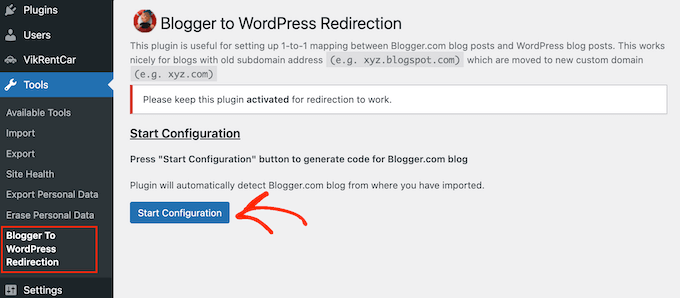
Il plugin rileverà ora l’URL del vostro blog Blogger e vi mostrerà l’opzione per ottenere un codice di reindirizzamento. Fare clic sul pulsante “Ottieni codice” accanto all’URL di Blogger.
A questo punto verrà generato uno snippet di codice necessario per reindirizzare correttamente gli utenti dal vecchio blog Blogger al nuovo sito WordPress.
Successivamente, è necessario accedere alla dashboard di Blogger e andare alla pagina “Temi”. Fate clic sulla freccia a discesa del pulsante “Personalizza” accanto al vostro tema e selezionate l’opzione “Modifica HTML”.
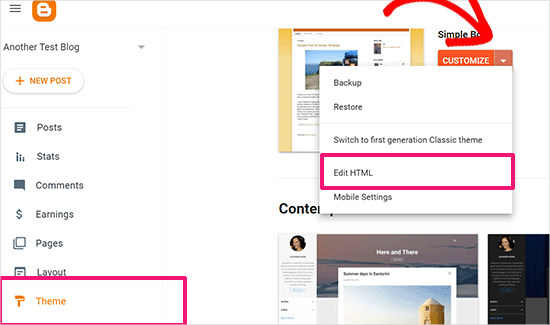
Blogger visualizzerà ora il codice HTML personalizzato per il modello del tema. Se sono state apportate delle personalizzazioni al tema di Blogger, è consigliabile copiare il codice e salvarlo sul computer come backup.
In caso contrario, è possibile procedere all’eliminazione di tutto. Dopodiché, copiate il codice visualizzato dal plugin sul vostro sito WordPress e incollatelo nell’editor del tema di Blogger.
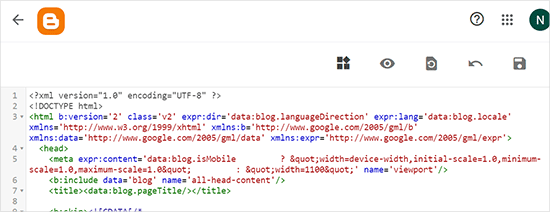
Non dimenticate di fare clic sul pulsante “Salva tema” per memorizzare le modifiche.
Successivamente, dobbiamo impostare i reindirizzamenti per gli utenti mobili.
È necessario tornare alla pagina dei temi nella dashboard del blog Blogger. Questa volta dovete fare clic sul pulsante dell’ingranaggio sotto l’anteprima mobile del vostro blog.
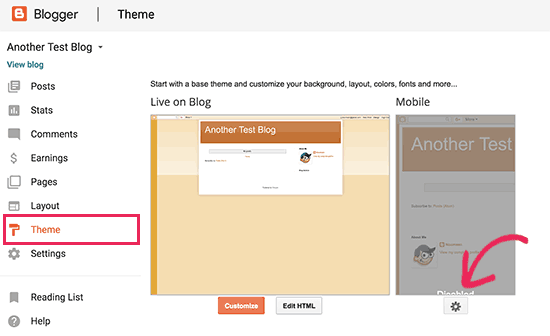
Si aprirà un popup in cui si dovrà selezionare l’opzione “No. Mostra il tema desktop sui dispositivi mobili”.
Quindi, fare clic sul pulsante “Salva”.
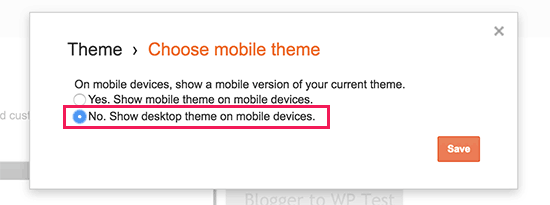
È tutto, il vostro blog Blogger ora reindirizzerà tutti i visitatori del blog al vostro nuovo blog WordPress.
In alternativa, è possibile utilizzare All in One SEO (AIOSEO) per reindirizzare post e pagine da Blogger a WordPress. Il plugin offre una potente funzione di gestione dei reindirizzamenti che consente di impostare reindirizzamenti completi al nuovo sito.

Inoltre, è possibile attivare il monitoraggio degli errori 404 e individuare eventuali link non funzionanti nel passaggio del sito a WordPress. In questo modo migliorerete l’esperienza dell’utente e non perderete il posizionamento delle parole chiave.
Utilizziamo AIOSEO per gestire tutte le pagine e le pubblicazioni di WPBeginner – e onestamente? I risultati ci hanno entusiasmato. Ecco perché lo consigliamo a tutti voi.
Per approfondire le nostre esperienze, consultate la nostra recensione dettagliata di AIOSEO.
Passo 5: Spostare altri contenuti da Blogger a WordPress
In questa fase, sposteremo i contenuti rimanenti dal vecchio blog su Blogger al nuovo blog WordPress. Questa operazione potrebbe richiedere un po’ di lavoro manuale, a seconda delle impostazioni/contenuti del vostro blog.
1. Spostare le pagine da Blogger a WordPress
Lo strumento di importazione di Blogger di WordPress importa solo i post di Blogger e ignora le pagine.
Per trasferire le vostre pagine in WordPress, dovrete modificare ogni pagina del vostro blog Blogger, copiarne il contenuto e poi creare manualmente una pagina in WordPress.
Per saperne di più sulle pagine, consultate il nostro articolo sulla differenza tra post e pagine in WordPress.
Ora vi imbatterete in un altro problema. Le pagine di Blogger hanno URL di questo tipo:
http://example.blogspot.com/p/about-us.html
L’URL della pagina di WordPress avrà il seguente aspetto:
http://example.com/about-us
Per risolvere questo problema, è necessario utilizzare il plugin All in One SEO (AIOSEO). Per le istruzioni, consultare la nostra guida per principianti sulla creazione di redirect in WordPress.
2. I widget
Come Blogger, anche alcuni temi di WordPress utilizzano i widget per aggiungere contenuti alla barra laterale del blog.
Per aggiungere i widget, è necessario visitare la pagina Aspetto ” Widget nella dashboard di WordPress e trascinare semplicemente i widget nelle barre laterali. Per istruzioni dettagliate, consultate la nostra guida su come aggiungere e utilizzare i widget in WordPress.
Se state cercando un widget specifico che non è presente in WordPress per impostazione predefinita, probabilmente avete bisogno di un plugin per WordPress. Potete cercare nella categoria dei migliori plugin per WordPress di WPBeginner per trovare la funzionalità che desiderate.
3. Feed RSS
I motori di ricerca e gli utenti che si iscrivono ai post del vostro blog tramite feed RSS saranno ancora in grado di trovare il vostro blog. Tuttavia, non riceveranno alcun nuovo contenuto.
Per risolvere il problema, visitate la pagina delle impostazioni del vostro account Blogger. Scorrete quindi la sezione “Feed del sito” e fate clic su “URL di reindirizzamento del feed del post”.
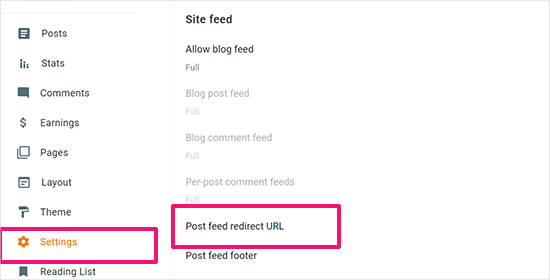
Si aprirà una finestra a comparsa in cui dovrete aggiungere l’URL del feed RSS del vostro sito web WordPress.
L’URL del feed di WordPress avrà il seguente aspetto:
http://example.com/feed
Non dimenticate di sostituire example.com con il vostro nome di dominio.
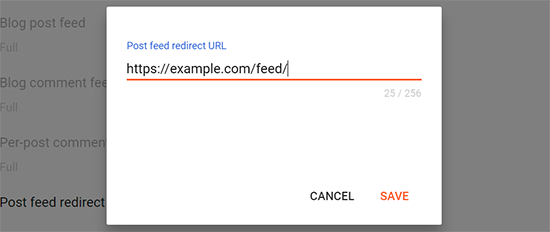
Fare clic sul pulsante “Salva” per aggiungere l’URL e salvare le impostazioni.
Passo 6. Cose da fare dopo la migrazione da Blogger a WordPress
Ora che avete trasferito con successo il vostro blog da Blogger a WordPress, vediamo cos’altro potete fare per migliorare il vostro blog.
Abbiamo creato una lista di controllo delle cose più importanti da fare dopo l’installazione di WordPress.
WordPress è abbastanza facile da usare. Tuttavia, di tanto in tanto scoprirete cose nuove per le quali potreste aver bisogno di aiuto. È qui che entra in gioco WPBeginner.
WPBeginner è il più grande sito di risorse gratuite per WordPress al mondo. Pubblichiamo regolarmente tutorial e guide scritte appositamente per blogger e piccole imprese.
Ecco alcune delle risorse utili che troverete su WPBeginner (tutte gratuite):
- WPBeginner Blog – Il luogo centrale per tutti i nostri tutorial e guide su WordPress.
- Dizionario WPBeginner – Il nostro glossario di WordPress è il posto migliore per familiarizzare con il gergo di WordPress.
- Video WPBeginner – I nuovi utenti di WordPress possono iniziare con questi video passo-passo per padroneggiare WordPress.
- WPBeginner su YouTube – Avete bisogno di altre istruzioni video? Iscrivetevi al nostro canale YouTube con più di 291.000 iscritti e oltre 50 milioni di visualizzazioni.
- WPBeginner Blueprint – Scopri i plugin, gli strumenti e i servizi che utilizziamo su WPBeginner.
- WPBeginner Deals – Sconti esclusivi su prodotti e servizi WordPress per gli utenti WPBeginner.
Video tutorial
Speriamo che questo articolo vi abbia aiutato a passare da Blogger a WordPress senza influenzare le vostre posizioni di ricerca su Google. Potreste anche voler consultare la nostra guida su quale piano WordPress dovreste utilizzare o i più comuni miti di WordPress sfatati.
Se questo articolo vi è piaciuto, iscrivetevi al nostro canale YouTube per le esercitazioni video su WordPress. Potete trovarci anche su Twitter e Facebook.





Mini
This useful even for moving free blog on blogspot to free blog on wordpress?
And will it transfer previously received comments too?
Katheriine
I have a problem with all of my pinterest pins stopping at a blogger page saying “this blog is no longer hosted by blogger do you wish to be redirected?” and you have to choose yes or no and obviously people usually just exit out or hit no so it’s killing my page views. Any help??
Susann
I don’t have the export blog (or import) button on my blogg. Only the Delete button. Did they take this away, how can I export my blog now? Or do I need to change anything somewhere else to get it to show up?
Eli
Hi, I don’t can’t use permalinks with /month/day, i need to use /blog-post-title.
is there a way to modify the php code, to get a proper redirect?
WAHEED HABIB
Dear Author, thank u so much for such a great help in transferring blogger data to wordpress theme. But redirection woud;nt work for me rather i use simple Blogger to WordPress Redirection plugin a very simple and easy to use tool i just love it. I have redirect my blogger site to WordPress.
Mallory
Hi! Thank you so much for this helpful guide!!
I’ve done everything as you explained and redirection works but I get this message on top of my wordpress: Notice: Undefined index: blogger in /var/www/vhost/example/home/html/wp-content/themes/betheme-child/functions.php on line 94
I therefore went and checked line 94 and this is the one: $blogger = $wp_query->query_vars[‘blogger’];
would you be able to help me?
Thank you so much
Patricia
Hi, currently trying to follow your instructions but I keep getting this message when I try to save the blogger redirection code in reference to the blog page title line.
“Error parsing XML, line 3, column 9: The content of elements must consist of well-formed character data or markup.”
Please help?
JC
Glad i found this. I’ve been so afraid to move my blog from blogger to W/P. One question: Do my followers on blogger also go with me?
Also, is there a way (don’t know what it’s called) to let those that come to your blogger site know that you’ve moved to W/P?
WPBeginner Support
If by followers you mean those who used Google ID to follow your blogger blog, then no.
Yes, using this method, people arriving at your blogger site through other sources will be properly redirected to your new site.
Admin
Lindsey
So helpful. However, when I refresh after all the steps, I get the 2nd code we pasted showing at the top. Am I missing something? It is even showing in my WP Admin dashboard!!
WPBeginner Support
It seems you pasted the code after a closing ?> php tag. You can paste the code again before the closing php tag or add this tag at the beginning of the code
<?phpAdmin
Katelyn
I am having the hardest time converting from BlogSpot to Word Press. For some reason I don’t know if it’s the browser I’m using or what but when I go to Settings –> Other —> to import and backup or backup content (those are the only two options it give me) I don’t have an export blog option. I’m getting ready to just freakin pay someone to do it!
Huda
What about the design theme? can I change it to wordpress theme?
Sy Abuzar
Hello. Brother.
This is Very Useful Article Amazing and Mind Blowing Guidelines Step by Step, I like It Thanks a lot,
Have a Nice Day Ahead
Febriyan
I had tried all the steps there and if I opened my blogspot blog on my computer, it worked just fine. It redirected automatically to the new domain on wordpress. But if I use my phone or asked my friend to access the blogspot, it didn’t do anything. No redirection at all.
Can you help me on this?
my blogspot is
Erin
Thank you for your post, super easy to follow and felt confident importing my blog. Though alas and alack I had trouble with the images, they didn’t import. I then followed your extra assistance for that scenario but whilst some imported to media library, some didn’t, and none are showing as featured images.
Any tips would be greatly appreciated.
collins
Thanks it helped,,Please i’ll love to talk 2 privately here is my mail address.
WPBeginner Support
Please use our contact page to send us private mail.
Admin
Mercedes
Thank you! This was super helpful.
Having a little trouble with the second code though. I have no idea how to even access the file I need to paste the code into?
WPBeginner Support
It goes in your theme’s functions.php file. Go to Appearance page in your WordPress admin area, and note the name of your active theme. Connect to your website using an FTP client, go to /wp-content/themes/your-active-theme-folder/ and there you will find functions.php file. Download it to your computer and open it with a plain text editor like Notepad. Paste the code at the end of this file. Save the file and upload it back to your theme folder using FTP.
Admin
Biz Harris
oh gosh, this was super helpful, but ONE note… maybe in the section about entirely changing the blogger code, be SUPER specific that you should change every “http://example.com” to your blog address AND that “www” beforehand isn’t necessary. I tried several iterations before I got this to work for me (and had a couple of panic attacks in the meantime.) anyway, thanks again from this VERY novie workpress beginner!
anyway, thanks again from this VERY novie workpress beginner!
Nicole
This was such a helpful blog post. So many people offer too much information or not enough, but you walked me straight through it! Thank you! I used Thad’s advice to get the mobile views to redirect. That worked.
My only problem now is that I can’t get my “pages” to redirect. They didn’t export/import, so I created new pages, with new names. Can I redirect these 15 pages manually in some way? or at least have a user redirected to my new home pages? Right now they are getting the message that “page you were looking for…does not exist.”
Thank you again! You have been so helpful!
Jwphoto
I’m having this same issue. When I google my blog name these old blogger pages (these were my menu items, not posts) show up. I can’t find a way in blogger to change the url. Is there a way to redirect these individual pages or change their url? Deleting these blogger pages would be bad for SEO, right?
Pascale
Hello, can you confirm where we should paste the 2nd code in function.php? I have read the Beginner’s guide to pasting snippets from the web into wordpress and it is still not clear.
Thank you so much for your help!
WPBeginner Support
It needs to go in your WordPress theme’s functions.php file. You can paste it at the very end of that file.
Admin
Vinayak SP
Above code not worked fully until you do this :
Configure Permalinks on New WordPress
From WordPress Dashboard, go to Settings -> Permalinks and select Custom Structure option and paste the following value next to it and save changes.
/%year%/%monthnum%/%postname%.html
Jas
Hello Syed,
1.
a) I notice in this article you specify the Permalink Settings as follows.
“choose Month and Name”
b) However in your How to “Move Custom Domain Blogger Blog to WordPress” your specify Permalink settings differently in custom format.
“/%year%/%monthnum%/%postname%.html”
2. I did not see the second article until I had already done the migration. I used a) above, then after the migration was complete, I changed it to b) above.
Why the difference between the two? Did I create a problem by beginning with a) then changing to b)? The Google search links seem to link correctly from old posts to new. Is there another factor I am not considering?
Thanks for your time,
Jas
urgent, priority
Tawnya
I have a question on where you copy the 2nd code on redirecting to wordpress do I just copy the code at the bottom of the functions.php file or is there a specific place on that page to copy the code??
Tawnya
I understand all of this except where do I paste the code in wordpress when you say this?
***However, you still need to setup redirection on your WordPress site so that users are redirected to the proper posts.
You need to copy and paste the following code in your WordPress theme’s functions.php file***
Do I just copy that code you provided at the bottom of this section on my wordpress or do I need to make sure it goes in a specific spot??
I hope that makes sense. Thanks for this tutorial
WPBeginner Support
Yes you need to copy the code in the bottom section and then paste it in your WordPress theme’s functions file. Check out beginners guide to pasting snippets from the web into WordPress
Admin
Tawnya
Where in the functions.php do I copy the second code though? I am still confused where that code is supposed to go?
Zara
I can’t find tools or anything in wordpress. Did they update it?
WPBeginner Support
Nope.
Admin
Amy Hunt
I can’t find tools in WP either..Publish, Personalise,Configure those are the only categories?
Lyssa
Thank you for this helping tutorial
i have been read almost full of your blog it’s very informative and helpful
WPBeginner Support
Thanks for the kind words.
Admin
Carla Mota
You are the best!! Thanks
Millo Magnocavallo
Add to previous comment …
I just looked at the source version of the text that’s been imported and in some cases the img tag is appearing like this:
for some reason it’s not printing out the src?
Paul Wentzell
This happens for me, also. I do see that the images for those posts downloaded to the site directory, but it’s curious why they were not inserted into the src of the post.
Millo
Hey! Thank you so much for a great tutorial / how-to. It worked really well, only that I’ve noticed that some images are not appearing in the imported blog posts. Do you have any idea why that might be?
Sharaj Khan
what about blogger to blogger ??????
Sam
easy, just backup template and then upload it on the other blog
Olsi
I followed this guide and it worked very well, but I did a redirect test and it says 302 Moved Temporarily and not 301 as it should be.
I`m I doing something wrong? Anybody else did a redirect test?
Paul
I’m also seeing a 302 from any redirect checker tool I am using. All links are indeed redirecting correctly, but 302 is making me uneasy.
Gianluca
Hi, is it possible to import only several posts from the older blog, instead the entire blog?
Thales
I found a work around…
I have replaced the code (line 11):
window.location.href=”http://example.com/?blogger=”
by the following 3 lines:
var str = “”;
var url_old = str.substr(7);
window.location.href=’http://pequenospelomundo.com.br/?blogger=’+url_old;
It works fine and seems that I have kept my google rankings.
Joel
I’m considering this option but am getting stuck on step #1. When I export an xml file from Blogger, the resultant file only includes 200 of my 1030 posts. Why? And what can I do to actually back up ALL of my blog.
Wordpresser
Do you still need to redirect the blogger blog to the wordpress domain if the URL structure including domain, date, article name and .html ending of the URL will all be exactly the same on WordPress as they are on Blogger?
Shelly
I have downloaded the blogger blog and am trying to import the file. It appears to be uploading but then I get the following error: Warning: Invalid argument supplied for foreach() in /home/content/p3pnexwpnas06_data02/87/2994987/html/wp-content/plugins/blogger-importer/blogger-importer.php on line 227
The blogger blog has almost 2,000 posts. Could the size be the problem? I’m afraid I am a complete newbie and am following directions step-by-step.
Kinshuk
Hi,
I am facing the similar issue to Shelly where I am getting following error:. I have around 2000 posts in blogger xml.
Regards.
Emilie
Thank you so much for such an informative and helpful video! I am totally a code newbie, but with your fantastic instructions, even I was able to get my blogger account to automatically send viewers over to my new domain. I only have one problem– and I think it has to do with the second set of code you had me post into the when the function.php file in wordpress. Rather than redirecting users to the specific article that they are attempting to reference in blogger, it just redirects to my entire, overall website. How can I fix it so that users who are clicking on old pinterest pins, etc, receive the recipe that they are looking for, rather than just a generic site where they have to search for the recipe they want? Thanks.
Fachreza
this is legal for blogger and wordpress ???
Michelle Dear
Yes. You own your data. You have the right to port it between tools.
Jericho
Thanks for this tutorial. I have a question, I am using custom domain in my blogger blog and this is the same domain I am going to use in WordPress. Do I have to disconnect the custom domain first and use the “blogspot.com” before heading to migration of my blog? If so, this will affect on my google rankings?
WPBeginner Support
Please see our guide How to move custom domain blogger blog to WordPress
Admin
Julia Taylor
Do you advise deleting the old blogger blog once the site is redirecting properly? Or should we wait for a certain period (if so, how long?)? Or is it best to leave it up for any reason?
WPBeginner Support
It is a free blog, why delete it if its not hurting your rankings? But if you must delete it, then we would recommend waiting for at least 6-12 months.
Admin
Julia Taylor
Well I guess I am not 100% confident we aren’t going to get hurt for duplicate content, since we are still seeing activity in the “Stats” tab. How do I test to make sure that is not going to happen?
Jason Booth
The 301 redirect and canonical tag should alleviate the fear about duplicate content but what I’ve found that this technique is not redirecting mobile traffic.
Mobile users are getting a different template on Blogger and not being redirected to the new site. I’ve been looking into it but have yet to find how to disable or change the template served to mobile devices.
Thales
I had the same issue (mobile users still accessing blogger). I have disabled mobile version in blogger and works fine.
Log in to blogger; go to template; click ‘update template’; on the top of the page you have the mobile preferences. Click and disable mobile version; then click back in ‘Revert to classic template’ – Done!
Julia Taylor
I am glad Jason pointed out the issue that mobile users are not being redirected. Can you guys please help us figure this out? I need the blog posts on mobile to also be redirecting to the new site, which they are not.
Julia Taylor
Oops, I missed the comment from Thales. Just did that, and it appears to be working. Thank you Thales!
Jason Booth
Thanks, Thales! Fixed it for me as well.
Julia Taylor
I followed all your instructions and everything seems to be working just fine, but we are still seeing some page views in the old Blogger site’s stats tab. Is it tracking the pages/posts that are redirecting to the new self-hosted WP site? Or is something not set correctly?
WPBeginner Support
Your blogger blog is not just visited by humans but also by many bots, crawlers, automated scrips, etc. Some of these bots may request a cached version of your blog this will generate a page view in Blogger’s stats. You can see the device information in your stats tab for that particular day.
Admin
Samantha
I’m trying to redirect my blog to my new wordpress site, but I’m turning all my blog posts into knowledge base articles.
How would I modify the code so that oldblog.blogspot.com/month/day/postname redirects to example.com/knowledgebase/postname
The “/knowledgebase” part is automatically added by the plugin I’m using and is not part of the permalinks structure.
WPBeginner Support
You can switch the post type to knowledgebase. We are not sure what kind of affect it will have on redirects. Its best if you test it on a local install with demo blogspot blog first.
Admin
Ketan
This was probably the easiest explanation of migrating from blogger to WP that I found till date. Thanks for posting. The redirect bit – that is something to do carefully.
Kim Brookes
I wrote a bit ago. You should probably ignore what I wrote because for some reason now it’s working. It’s either working now because I copied the snippet for the blogger template again, and changed the “example.com”s again. Or, because the links embedded on my WP site posts (that were ported from blogger) still have the blogger URLs, which WP interprets by substituting .blogger.com with my.new.url, which goes 404 on WP.
That is, in case it’s helpful, the post that was on blogger, now WP:
included a link in the text to
which somehow in the migration, or me doing something wrong, got changed into
and that’s a URL that doesn’t exist (WP with a .html instead of /)
So, mostly thanks for your awesome site. And ignore my previous comment.
-Kim
WPBeginner Support
We are glad you successfully migrated your website.
Admin
Kim Brookes
Awesome site you have here! I’ve used all sorts of the articles.
I’ve followed all of the instructions on this “how to switch” page. Most of it is working, but the old links on Blogspot aren’t redirecting to my new domain. They’re going to a 404. This is because the old blogspot URLs end in .html, and the new WordPress URLs end with the post_title/
as though it’s a directory instead of old-fashioned .html file. I think the issue is with the WP function code, but I don’t know the coding well enough to guess at how to make WP redirect to a (delete the slash, add “.html”) URL.
Nor do I know how to add the coding to the WP permalink page. I don’t want to mess with this, though because I don’t want “.html” added to all of my new posts. For now, the only think I can think to do is to change the permalink individually on all of my migrated-to-WP blogspot posts. Yuck.
Thanks for any help you can provide.
Julia Taylor
Thank you SO MUCH for this post…it really helped me! I do have a question. Is it possible to redirect the main blog address to a page on the site? The reason I am asking is because the new blog is just part of site, and redirecting blog reader to the homepage might be confusing. So can can I redirect example.blogspot.com to http://www.example.com/blog/, instead of http://www.example.com? I am a little nervous to go messing with your beautiful redirect code as I do not want to mess it up! Thanks so much!!!
WPBeginner Support
Yes, you can do that.
Admin
Christene
Before I begin doing this, I need to know something: Once all the content on my Blogger site is imported to WordPress…will all the imported posts automatically go live? Or will they import as a draft status? I wouldn’t want them to go live yet. The reason for the migration would be a stand-by thing, in case Blogger deletes my blog (they’ve already deleted two without any pre-notice to me, claiming they had spam), so I’m afraid they’re going to pull this stunt on my remaining blogs.
So as a pre-emptive, I’d like to install WP, set it up and import, but keep all the imported content in draft status as long as my blogs are still up. If Blogger notifies me they took down my other main blog, then that’s when I’d switch the WP draft status to published. Will someone please let me know about this? I’d hate to have my articles live on BOTH sites at the same time.
WPBeginner Support
All imported posts will go live.
You can go to Posts and click on the screen options button on the top right corner of the screen.
Under number of posts to show, select a number higher than the expected number of posts you think you might have. Click on the apply button.
WordPress will now show all your posts. On the top right corner of the posts list, you will find a checkbox to select all posts visible on screen.
After selecting all your posts, under bulk actions drop down menu, select Edit and then click on apply button next to it.
WordPress will now show you bulk editing options. Click on drop down menu next to Status section and then select Draft. Finally click on the update button. All your posts will now become drafts.
Admin
Tiffany MacBain
I followed the steps to import to WordPress from Blogger and received the message (on WP) that the import was in progress. How long does the import process take? It’s been 30 minutes so far, and I see none of my Blogger posts on WordPress. Thanks!
Laura McKissack
I wish I had come across this article a long time ago! I can’t believe I just crossed this off my to-do list in ten minutes. I’ve been putting it off forever because I thought it would be hard, ha. Now I have to figure out how to recover all the media files blogger has lost from my old blogs Any advice there?
Any advice there?
Christene
I can’t believe you did this in only 10 minutes, Laura. It would take me at least 10 minutes just to READ through the instructions. And the images of all the HTML coding? And what to do with it? This looks as hard as the dickens.
Shakir
Thanks for the great tutorial .
But i want to ask that i also want to migrate blogger blog to wprdpress but i have to use the same domain name on wordpress , so what should i have to do for the proper redirection of posts to the new post urls so that the exact post url which is ranking in google should redirect to exact same post of wordpress ?
mahesh
Hello ty for such a great article. I want to migrate my blog to WordPress. The template which I m having right now will it available after migration or I Will have to use other?? And if I loose that template then how can I insert new theme in WordPress?
Plsss reply waiting for you
WPBeginner Support
No Blogger templates are different than WordPress. However, you should be able to easily find a much better theme for your WordPress site.
Admin
mahesh
I have already bought domain from godadday , now if I migrate to WordPress then how will I can use that in word press? I mean how will I able to transfer domain to WordPress? Pls repl
WPBeginner Support
You will need WordPress hosting. Once you have signed up for a hosting account, you will need to edit your domain settings on GoDaddy. Under domain settings locate Name Servers and then change them point to your new WordPress host.